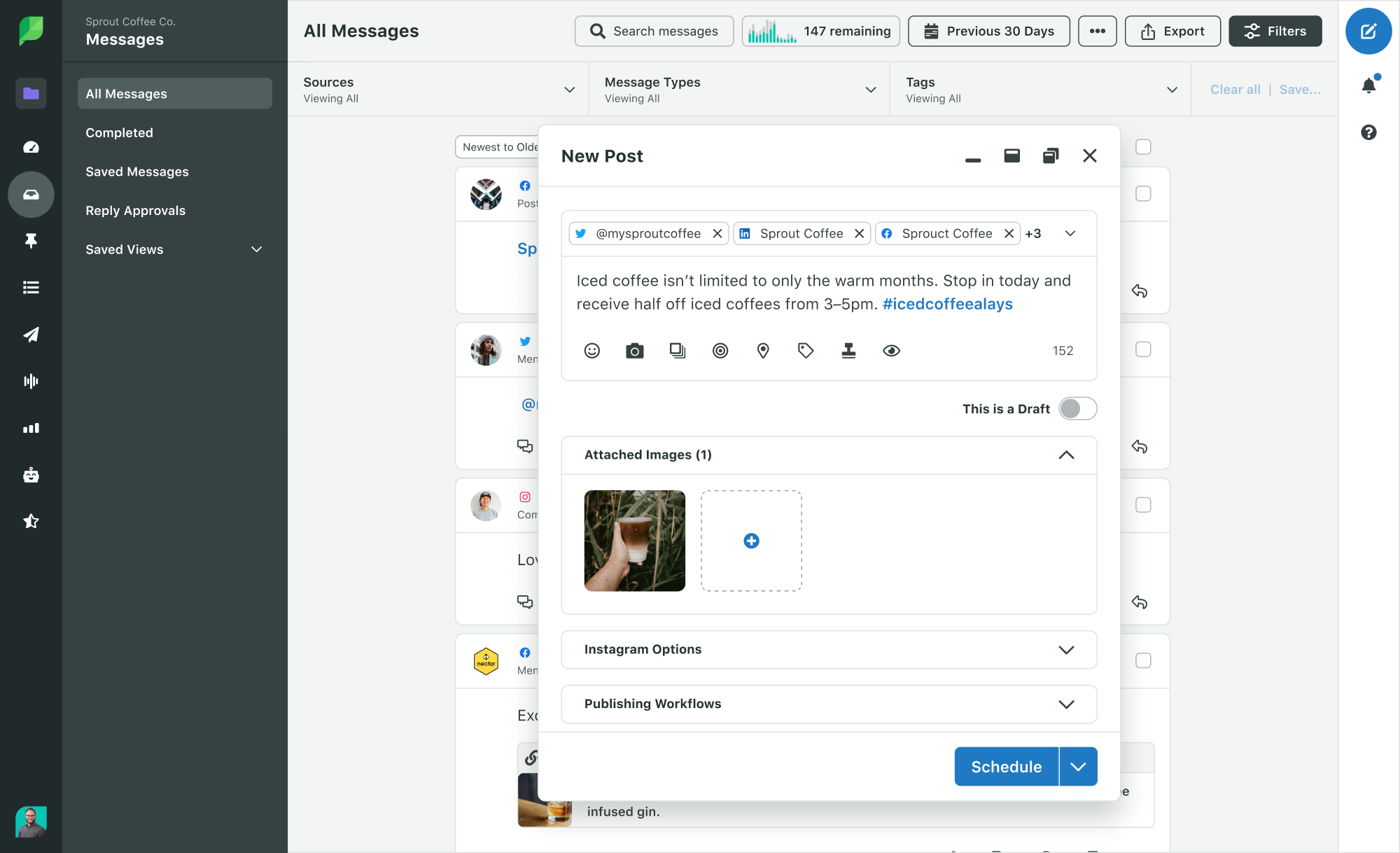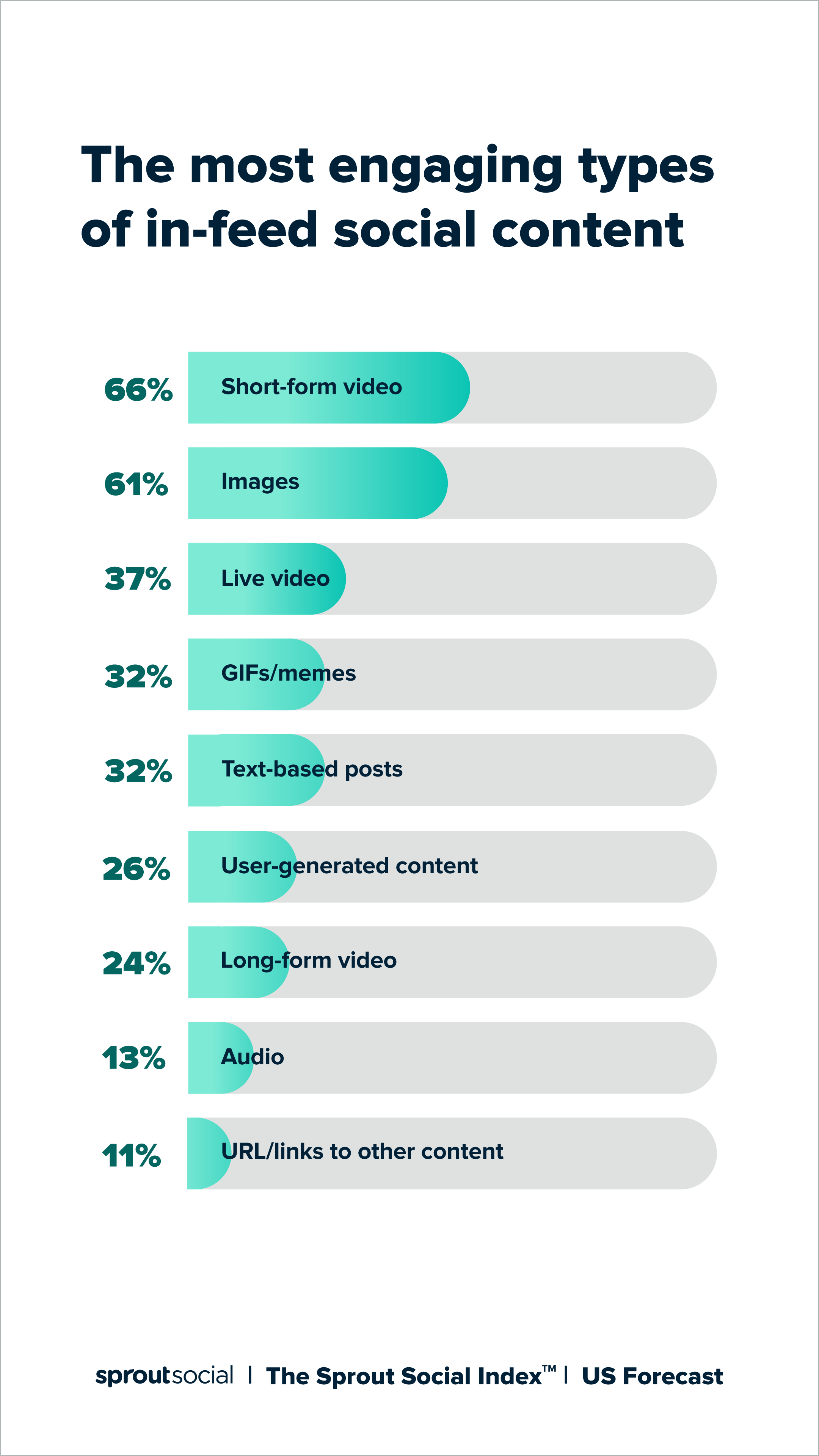[Full Guide] Social Media Management – Sprout Social

Send us an email
Send us an email
Search the Blog
Social Media Management
Reading time 10 minutes
Published on March 23, 2023
Social media management is the ongoing process of creating and scheduling content designed to grow and nurture an audience across social media platforms. This includes, but is not limited to:
The benefits of social media management go far beyond raising brand awareness and staying current on the latest internet trends. The channel is key to building more personal connections with target audiences at scale. The rapport developed on social can build brand trust, affinity and best of all, loyalty.
The definition of social media management is anything but fixed. Platforms and trends are constantly changing, meaning the responsibilities that go into managing a brand account are always changing as well.
For example, in less than a few years we’ve seen the creator economy completely transform how we post on social. The rise of social messaging has brought conversations from public to private, creating more personal connections between people and the brands they love. Social commerce has revolutionized how business leaders perceive the channel, taking it from awareness-focused to a full-funnel experience.
These developments prove one thing: social is driving how consumers interact with businesses, making social media roles business critical.
Social media managers are responsible for developing the strategies that maintain and grow a social presence, on top of administrative and team development tasks. Any given day might involve content creation, campaign strategies, career planning, analytics reporting—the list goes on.
Being successful in such a fluid role requires a unique set of skills, including but not limited to:
Combined, these talents help social media professionals manage the evolving needs of this business-critical channel.
It is both an art and a science to manage social media accounts. Your data can give you a good idea of how to spend your resources—in terms of both money and time—but social moves quickly. The platform delivering results today might take a dip tomorrow.
Diversifying your network strategy is a reliable way to ensure that you’re ready for whatever challenges are thrown at you. An algorithm update on one platform is less of a shock to the system if you have a well-maintained presence across the social landscape.
This is where a social media management tool becomes a must-have. Posting natively (requiring logging into each social network individually in order to post) across social media profiles is a huge time commitment. Factor in engagement and monitoring, and it becomes more than a full-time job.
Tools like Sprout help businesses scale social operations sustainably. Publishing workflows support customization by network while minimizing risk. After all, managing quality control is much harder when your team is running social natively.
These features automate and complement existing processes so you can get out of the weeds and into the bigger picture.
The key to creating impactful content is identifying your target audience. These are the people that sit within your brand’s total addressable market. Zeroing in on these individuals will allow you to create more effective messaging across your social media profiles.
To better find and appeal to your brand’s target audience, ask the following questions:
The answers to these prompts will inform your approach to social—what platforms you’re present on, how your brand sounds online, what trends appeal to your audience and how you connect with customers.
Getting to know your audience is not a one-time-only practice. Asking yourself and your team these questions on a routine basis can keep everyone in a customer-first mindset.
Content creation is a fundamental aspect of social media management. People may log on to their favorite social networks to connect with friends and family, but more than one-third (36.3%) stay to fill time.
You can use these spare moments to create lasting connections with your audience, but the competition is stiff. On social, you’re not only up against direct competitors, but other elements vying for attention on these platforms. Marketers need to account for other sources of content, like media outlets, publications and creators.
To stand out, you need to know what people want.
Is your audience looking for entertainment? Commentary on trending topics? A community? Tips and tricks? There are a lot of different reasons consumers turn to brands on social. Finding out where you fit can help your business maintain relevance in an always-on social landscape.
When it comes to formats, the most engaging type of in-feed social content is short-form video. It gained popularity thanks to the meteoric rise of TikTok and has now spread to every major social platform in some way or another.
Short-form video is a powerful way to capture your audience’s attention without requiring a major time commitment on their end. However, a diversified social media marketing strategy makes use of all types of content. This may seem overwhelming, but it’s actually an opportunity in disguise.
A post shared by Sprout Social (@sproutsocial)
You can use a single live video stream to create dozens of short-form video clips, GIFs, text posts and more. At Sprout, we use our See Social Differently podcast to inform posts across networks like Instagram, Twitter, LinkedIn and TikTok.
Data from The Sprout Social Index™ 2022 shows that more than three-fourths (88%) of marketers anticipate expanding their team over the next two years.
This type of growth can be an amazing opportunity, but it does come with a learning curve. Developing your team’s talent also means committing to your ongoing development.
Here are four skills to work on as you build out your social media team:
Have you ever thought about buying from a company only to find out they have poor online reviews? Did you follow through on that purchase? If you didn’t, you’re not alone.
According to a study from BrightLocal, just 3% of shoppers say they would consider using a business with an average rating of two or fewer stars.
Social media reputation management is a critical yet often overlooked aspect of social media management. While it may not fall under a social professional’s core responsibilities, it’s vital to the success of all businesses.
If you’re new to online reputation management, here are three rules that can guide your strategy:
You don’t have to wait for reviews to roll in on their own. Sometimes, you just need to ask.
Reach out to fans and power users to see if they’d be interested in sharing their experiences with your product or services. Be sure to make the process as easy as possible. Providing a specific prompt or template can increase customer follow-through.
That same BrightLocal survey found that more than half of consumers are unlikely to use businesses that don’t respond to reviews.
Responding to negative reviews can be difficult but it’s also a powerful way to let consumers know that you hear and respect their feedback.
Feedback won’t always come through direct channels. People often will talk about your business on their personal profiles without tagging or mentioning your brand account.
A social listening strategy can help you stay on top of the many conversations surrounding your business and industry. Use a social listening tool (like Sprout’s!) to support an opportunity-driven brand reputation management strategy that helps you create lasting connections with your audience.
Managing an active social media presence with native publishing tools was challenging five years ago. Today, it’s virtually impossible to do alone.
Between sharing content, responding to consumers and managing paid initiatives, social media calendars are more jam-packed than ever. Businesses must invest in social media management and scheduling tools to keep up with the demands of a modern social media strategy.
These tools can do more than save time. The benefits of a social media management tool include the following:
Adopting a social media management tool can enrich your entire marketing tech stack, making it easier to connect the dots on social’s impact across your organization.
Your social media content strategy outlines the overarching themes that inform your publishing schedule and how it relates to business goals. Your social media content calendar provides a more granular look at what you’re posting and when across platforms.
In an ideal state, your content calendar can support organization and brainstorming. A bird’s eye view of your upcoming social media posts can help determine if you’re hitting the content mix outlined in your strategy.
For example, say recruiting top talent is a high priority for your business. A look at your social media content calendar can tell you whether or not you have enough employer brand posts scheduled over the next week or month.
This visibility will make it easier to identify which content themes need more attention. Pro tip: if you’re using Sprout, you can use the Calendar Notes feature to keep track of potential content ideas.
If you’re weighing the merits of relying on organic vs. paid social media, don’t worry—there’s no need to choose.
Your organic efforts support long-term relationships with your followers. Your social media advertising strategy, on the other hand, will help you reach new audiences quickly and reliably through targeting.
Managing your organic and paid efforts together can keep a brand top of mind with existing and prospective customers. If you can manage them within the same tool, that’s even better.
For example, Sprout supports in platform paid social promotion and reporting so marketers can keep their finger on the pulse of their performance. That way, you can ensure money is being spent effectively and make any necessary adjustments if it’s not.
Online communities have been around for a while, but they’ve never been more important than they are today.
Take Canva’s Facebook group for instance. Canva Design Circle is home to more than 250,000 members seeking peer-to-peer design advice.
The conversations happening within the group might not always be product-focused—they don’t have to be. Posts that aren’t product-related still provide their team with an invaluable look into the needs of their audience.
Thanks to the rise of communities like these and vertical social networks, more and more people are taking their online interactions behind the walls of private groups. If you want to stay connected to your target audience, the best thing you can do is give them a place to make connections of their own and build a social community.
Like Rome, an active social media community can’t be built in a day. If you’re launching new programming or an entirely new community, take a slow and steady approach.
Start with an invite-only beta program designed for loyal customers and power users to test drive your strategy. Once you’re in a groove, you can expand to a larger audience.
If you’re looking for more resources on social media management, we’ve gathered additional reads below that can be found throughout our site.
Social media provides businesses with the insights and intelligence needed to understand where they fit in today’s cultural landscape. A strong social media management strategy does more than just maintain an online presence. It can help a brand gain relevance, earn fans and future-proof itself for years to come.
When you take native publishing out of the equation, you open your team up to a world of possibilities. Sprout’s intuitive social media publishing tools minimize manual efforts so you can focus on strengthening your strategy and connecting with your customers.
19 social media tools for your brand in 2024
Salesforce’s social media team saves 12,000 hours in first year using Sprout Social
Social media management costs for businesses in 2023
What is social media management? Everything you need to know
Find Your Next Social Media Management Tool With This Scorecard
Social Media Management Buyer’s Guide
7 social media management integrations brands need
Top 18 social media management tools for businesses in 2023
Social media management services: 9 agencies your brand should check out
17 social media management tips for productivity and organization
10 tips on how to effectively manage your Instagram followers
Sprout Social helps keep NJ TRANSIT’s social strategy on track
Plan, launch, report: How to master social media campaign management
The right time to invest in new enterprise social media software
How to manage multiple Twitter accounts easily
Indiana University uses Sprout to empower decision making
How Telfer School of Management connects to what matters with Sprout Social
How to build a brand with celebrity social media management
How Benefit turns cosmetics into connection using Sprout Social
How Loews Hotels & Co succeeds at scale with Sprout Social’s all-in-one platform
How the University of North Dakota Optimizes Performance Using Sprout Social
Northwestern Settlement Uses Sprout Social to Save Time, Engage Target Audiences
How the City of Lenexa Engages its Citizenry Using Sprout Social
How Sprout Social Empowers the St. Louis Blues Online and in the Arena
Digital Natives Group Doubled Its Average Client Retainer With Sprout Social’s Agency Partner Program
How KISS Slays in Style on Social Media by Using Sprout Social
KETTLER Uses Sprout Social to Engage Customers Across Broad Real Estate Portfolio
How Sprout Social Made Implementation a Pain-free Process for Atlantic Lottery
How American City Business Journals Efficiently Manages Its 43 Markets on LinkedIn
Using Sprout to Strengthen the Content Strategy of a Franchise
Build and grow stronger relationships on social
Sprout Social helps you understand and reach your audience, engage your community and measure performance with the only all-in-one social media management platform built for connection.
© Copyright 2023 Sprout Social, Inc. All Rights Reserved. Privacy | Terms of Service | Website Terms | Disclosure Policy | Cookies | Do Not Sell or Share My Personal Information
Filter by




